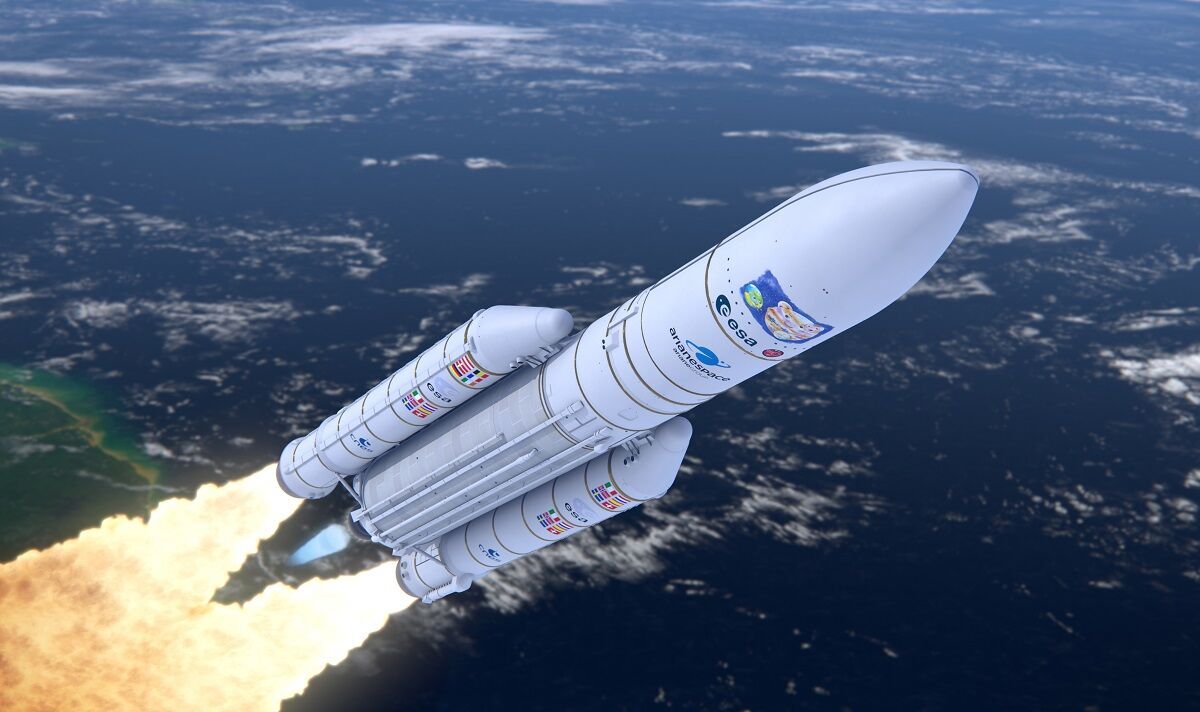Juice’s odyssey of exploration
The European Space Agency (ESA)’s Jupiter Icy Moons Explorer — or JUICE, for short — is scheduled to launch this afternoon.It will blast off at around 1.15pm BST, and the pioneering mission will leave Earth atop an Ariane 5 rocket, launching from the Guiana Space Centre in Kourou, French Guiana, South America.
Following an eight-year cruise, the craft will study Jupiter and three of its icy moons, which tantalise with the prospect of harbouring alien life in their subsurface oceans. JUICE will also enter the record books in December 2034, when it is scheduled to become the first spacecraft to enter into orbit around a moon other than Earth’s — specifically, Ganymede, where the probe will conclude its 11-year mission.
Various other worlds in our Solar System have been proposed to be potentially capable — or once capable — of harbouring extra-terrestrial life.
These include, in the past, Mercury and Mars, which are believed to have once played host to water ice and liquid water — and, in the present, the dwarf planet of Ceres that lies in the asteroid belt between the Red Planet and Jupiter, and has a thin water-vapour atmosphere.
Among the most promising candidates, however, are the large icy moons of Jupiter, three of which — Callisto, Europa and Ganymede — are believed may well have vast, miles-deep subsurface oceans capable of supporting life.
In fact, in 2012, NASA’s Hubble Space Telescope detected what experts believed may be plumes of water erupting from Europa’s buried ocean.


April 13, 2023 — Launch from the Guiana Space Centre
August 2024 — Flyby of Earth and the Moon
August 31, 2025 — Flyby of Venus
September 29, 2026 — Second flyby of Earth
January 18, 2029 — Third flyby of Earth
July 2031 — Arrive in Jupiter’s orbit
December 2034 — Depart Jupiter orbit
December 2034 — Arrive Ganymede’s orbit
Late 2035 — Deorbited, impact with Ganymede

The JUICE spacecraft has been equipped with 10 different scientific instruments to study both the atmosphere, magnetic environment, ring system and satellites of Jupiter; as well as the moons of Callisto, Europa, Ganymede, characterising their oceans, icy shells, surfaces and activity.
Data collected should help scientists better understand how gas giants form, how Jupiter’s complex environment has shaped its moons and vice versa, the nature of the subsurface oceans on the Jovian moons and whether such now or once supported life.
The craft even includes an ice-penetrating radar system that will allow scientists to map out the subsurface oceans.
The findings from this undertaking could well help scientists plan a potential future mission deploying a submersible craft into these waters.


In a press release, an ESA spokesperson said: “JUICE, is humankind’s next bold mission to the outer Solar System.
“It will make detailed observations of gas giant Jupiter and its three large ocean-bearing moons — Ganymede, Callisto and Europa.
“This ambitious mission will characterise these moons with a powerful suite of remote sensing, geophysical and in situ instruments to discover more about these compelling destinations as potential habitats for past or present life.
“Juice will monitor Jupiter’s complex magnetic, radiation and plasma environment in depth and its interplay with the moons, studying the Jupiter system as an archetype for gas giant systems across the Universe.”
The craft, they added, “has an eight-year cruise, with flybys of Earth and Venus, to slingshot it to Jupiter. It will make 35 flybys of the three large moons while orbiting Jupiter, before changing orbits to Ganymede.”
DON’T MISS:
Space’s benefits to the UK highlighted in campaign backed by Tim Peake[INSIGHT]
Erased scrap of early New Testament translation recovered from Vatican[REPORT]
Vesuvius mystery solved as experts warn of hazard to modern-day Naples[ANALYSIS]


How to watch it
The ESA is providing livestreamed coverage of the JUICE mission launch, beginning at 12.45pm BST this afternoon, April 13, 2023.
The stream can be watched either directly on ESA Web TV, or via the ESA’s YouTube channel.
Following the launch at 1.15pm BST, the JUICE craft will separate from the upper stage of the Ariane 5 rocket at 1.42pm BST.
It is expected that it will take around 10 minutes at least from ground control to acquire the first signal from JUICE.
The mission
Following launch, two monitoring cameras on board the craft will capture images of the solar array being unfurled, an undertaking that is expected to be completed by 2.55pm BST.
A few days into the mission, the same cameras will photograph the deployment of the 52 feet-long radar antenna — which will probe the icy surfaces of Jupiter’s moons down to a depth of 5.6 miles — along with its other antennas and instrument booms.
Following this, an intensive three-month-long commissioning process will prepare and check JUICE’s scientific instruments to ensure all is ready for arrival at Jupiter.
The mission will be making use of four gravity-assist flybys in the inner Solar System to help slingshot it to the Jovian system.
The first of these, a so-called lunar–Earth gravity-assist, will see JUICE flyby the Moon and then, 1.5 days later, the Earth, in the August of next year.
Source: Read Full Article
